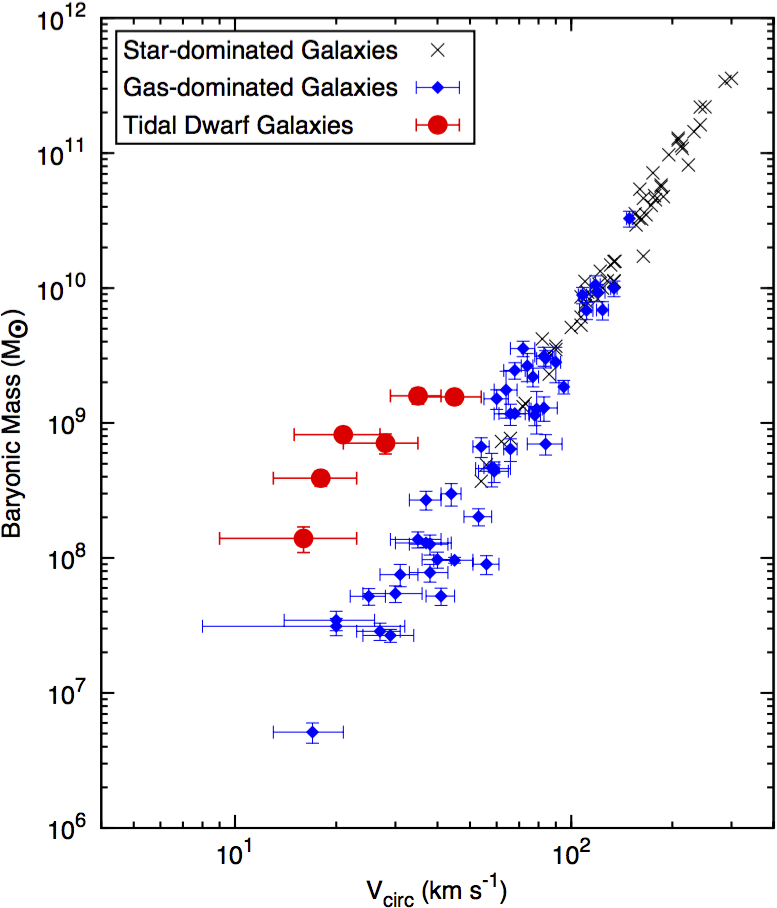


Tidal dwarfs galaxies (TDGs) are dwarfs that form from the tidal debris of baryonic material liberated from giant galaxies by interactions with other galaxies. As described previously, TDGs provide a key test of both dark matter and MOND because they should behave differently in each case. In MOND, they should still exhibit mass discrepancies if they are in the low acceleration regime, while in conventional dynamics, they should be stripped of their dark matter and appears as naked, purely Newtonian systems. The latter situation would be an ironic confirmation of dark matter by its absence.
Initial work by Bournard et al. (2007, Science, 316, 1166) suggested that the TDGs of NGC 5291 had small mass discrepancies. Since TDGs shouldn't retain any dark matter from the quasi-spherical halo, but they seemed to have a little bit, they suggested that there was some baryonic dark matter (e.g., cold gas) in the progenitor disk. Gentile et al. (2007) considered this matter further, concluding that the TDGs of NGC 5291 were consistent with the Baryonic Tully-Fisher relation. This implies a mass discrepancy uniquely consistent with MOND.
 Motivated by the potential for TDGs to provide a definitive answer to this problem,
we've been studying these and other TDGs. After careful modeling of the data cubes in 3D,
Lelli et al. (2015) find that the TDGs in
NGC 5291, NGC 4694, and NGC 7252 (the Antennae) do not appear to obey the Tully-Fisher relation.
Instead, they fall to the left of the relation defined by normal disk galaxies, having lower
rotation velocities for their baryonic mass. Indeed, the enclosed dynamical mass is
consistent with just that of the observed stars and gas.
Motivated by the potential for TDGs to provide a definitive answer to this problem,
we've been studying these and other TDGs. After careful modeling of the data cubes in 3D,
Lelli et al. (2015) find that the TDGs in
NGC 5291, NGC 4694, and NGC 7252 (the Antennae) do not appear to obey the Tully-Fisher relation.
Instead, they fall to the left of the relation defined by normal disk galaxies, having lower
rotation velocities for their baryonic mass. Indeed, the enclosed dynamical mass is
consistent with just that of the observed stars and gas.
This completely inverts the interpretation. These TDGs appear not to need any dark matter. This is precisely the result we expect in the case of conventional dynamics, not MOND.
So - case closed, right? Perhaps. But there are some caveats.
First, in no case have we adequately resolved the rotation curve of the TDG. The models we construct are consistent with the data, but we must assume a rotation curve shape. It is hard to judge how unique the successful model is, and nowhere near as satisfactory as seeing the expected Kaplerian rotation curve.
Second, the time scales are inconvenient. Dynamical analyses generally assume that equilibrium has been achieved, so the observed motions are tracing a settled gravitational potential. That is not obviously true in TDGs. In the cases we have studied in Lelli et al. (2015), the orbital time at the outer edge of each TDG is comparable to or longer than the time since the tidal interaction that created the TDGs in the first place. I find it hard to imagine that an object that hasn't had time to complete one rotation has settled into virial equilibrium.
Third, it is not entirely obvious that TDGs are in the isolated MOND regime - the condition by which they should lie exactly on the baryonic Tully-Fisher relation. The external field imposed by the host galaxy may play a role. Initially, this appeared negligible, but perhaps not on closer calculation. If the external field is significant, it will have the net effect of shifting TDGs off the TF relation leftwards, as observed. Worse, since these TDGs are the products of on-going tidal interactions, the temporal variation of the external field may be important. Ick.
Personally, I doubt whether the external field effect is enough to save MOND from this result. On the other hand, the time scale worries me quite a lot. If it were LCDM that failed here, would anyone accept such a result based on objects that haven't had a chance to complete even one rotation?
We are currenlty (2015) making new observations of other TDG systems. Hopefully these data will address these issues. One system in particular was chosen for its apparent age - the TDGs should have had time to settle. ALMA should be able to adequately resolve the rotation curves. Whether Nature will provide enough signa to overcome the noise remains to be seen.
So - stay tuned. Further updates as events warrant.
